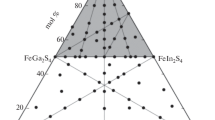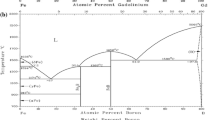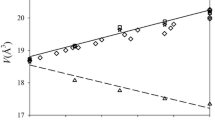Abstract
(Fe, Mn)S and (Fe, Mg)S solid solutions are examined to study and compare the properties of Fe2+ in two different B1-structured hosts, and also to study the relative stability of the B1 (NaCl) and B8 (NiAs) structures at high pressure. The Mössbauer spectra of (Fe, Mn)S and (Fe, Mg)S B1 solid solutions are quadrupole doublets at 298 K with parameters which vary smoothly with Fe2+ concentration. At 4.2 K the Mössbauer spectra of (Fe, Mn)S and Fe-rich (Fe, Mg)S B1 solid solutions are magnetically split into eight lines, but the spectra of Mg-rich (Fe, Mg)S solid solutions are quadrupole doublets. The line widths of the magnetic spectra are broad, consistent with a multiaxial spin arrangement. Some properties of the hypothetical phase FeS(B1) are calculated from the solid solution data; the phase is inferred to be relatively ionic compared to FeS(B8) and has a molar volume that is 7.2 percent larger than the B8 phase at 298 K. The large inferred volume difference between FeS(B1) and FeS(B8) should cause exsolution of a B8-structured phase from (Fe, Mn)S and (Fe, Mg)S B1 solid solutions at high pressure. This behaviour is confirmed experimentally at high pressure using X-ray diffraction and Mössbauer spectroscopy, and the results are correlated with thermodynamic calculations of the phase boundaries based on estimates of the volume and free energy differences between the B1 and B8 phases of FeS derived from atmospheric pressure data. The absence of an increase in solubility of Mg and Mn in the B8 phase with pressure suggests that any polymorphism in MnS and MgS at high pressure is unlikely to involve the B8 phase. Shock wave data for MgO and Fe0.94O reported in the literature suggest similar behaviour in the system FeO-MgO at high pressure, namely exsolution of essentially pure FeO(hpp) from (Fe, Mg)O B1 solid solutions.
Similar content being viewed by others
References
Arnold RG, Reichen LE (1962) Measurement of the metal content of naturally occurring metal-deficient, hexagonal pyrrhotite by an X-ray spacing method. Am Mineral 47:105–111
Boyd FR, England JL (1960) Apparatus for phase-equilibrium measurements at pressures up to 50 kilobars and temperatures up to 1,750° C. J Geophys Res 65:741–748
Cemic L, Neuhaus A (1972) New high-pressure modification of manganese selenide of the nickel arsenide type and miscibility of manganese selenide-manganese telluride. High-Temp-High Pressures 4:97–99
Clendenen RL, Drickamer HG (1966) Lattice parameters of nine oxides and sulfides as a function of pressure. J Chem Phys 44:4223–4228
Collins DW, Dehn JT, Mulay LN (1967) Supermagnetism and Mössbauer spectroscopy: a review and new results on iron dispersion. Mössbauer Effect Methodology, vol 3 (ed Gruverman) Plenum Press, New York, pp 103–122
Corliss L, Elliott N, Hastings J (1956) Magnetic structures of the polymorphic forms of manganous sulphide. Phys Rev 104:924–928
Fleet ME (1975) Thermodynamic properties of (Zn, Fe)S solid solutions at 850° C. Am Mineral 60:466–470
Green TH, Ringwood AE, Major A (1966) Friction effects and pressure calibration in a piston-cylinder apparatus at high pressure and temperature. J Geophys Res 71:3589–3594
Hafner S, Kalvius M (1966) The Mössbauer resonance of Fe57 in troilite (FeS) and pyrrhotite (Fe0.88S). Z Kristallogr 123:443–458
Heikens HH, Wiegers GA, van Bruggen CF (1977) On the nature of a new phase transition in α-MnS. Solid State Comm 24:205–209
Hirone T, Maeda S, Chiba S, Tsuya N (1954) Thermal analysis of iron sulphides at the temperature range of the β-transformation. J Phys Soc Japan 9:500–502
Jackson I, Ringwood AE (1981) High-pressure polymorphism of the iron oxides. Geophys J R Astron Soc 64:767–783
Jeanloz R, Ahrens T (1980) Equations of state of FeO and CaO. Geophys J R Astron Soc 62:505–528
King HE, Prewitt CT (1982) High-pressure and high-temperature polymorphism of iron sulphide (FeS). Acta Crystallogr B38:1877–1887
Kündig W (1967) Evaluation of Mössbauer spectra for 57Fe. Nucl Instrum Methods 48:219–228
Kurash VV, Kulikov GA, Makarov EC (1973) Study of Mg and Fe isomorphism in “ninningerite” MgS, “troilite” FeS system (in Russian). Geokhimiya 8:1266–1267
Liebermann RC, Ringwood AE, Mayson DJ, Major A (1974) Hotpressing of polycrystalline aggregates at very high pressure for ultrasonic measurements. Proc 4th Int Conf High Pressure, Kyoto, Phys-Chem Soc Japan, pp 495–502
Liu LG (1981) Structural considerations in high-pressure phase transformations of simple crystals. High Temp-High Pressure 13:387–398
Mann GS, Van Vlack LH (1976) FeS-MnS phase relationships in the presence of excess iron. Metall Trans 7B:469–475
Mao HK, Zou G, Bell PM (1981) High-pressure experiments on FeS with bearing on the composition of the Earth's core. Ann Rep Geophys Lab 80:267–272
McCammon CA (1983) Aspects of the high-pressure behaviour of iron oxides and sulphides. Ph.D. Thesis Australian National University, 152 pp
McCammon CA, Price DC (1982) A Mössbauer effect investigation of the magnetic behaviour of (Fe, Co)S1+x solid solutions. J Phys Chem Solids 43:431–437
McCammon CA, Ringwood AE, Jackson I (1983) Thermodynamics of the system Fe-FeO-MgO at high pressure and temperature and a model for formation of the Earth's core. Geophys J R Astron Soc 72:577–595
Morosin B (1970) Exchange striction effects in MnO and MnS. Phys Rev B 1:236–243
Navrotsky A, Davies PK (1981) Cesium chloride vs. nickel arsenide as possible structures for (Mg, Fe)O in the lower mantle. J Geophys Res 86:3689–3694
Ono K, Ito A, Hiraharo E (1962) Mössbauer study of hyperfine field, quadrupole interaction and isomer shift of Fe57 in FeS1.00, FeS1.05 and FeS1.07. J Phys Soc Japan 17:1615–1620
Pollard RJ, McCann VH, Ward JB (1983) Magnetic structures of α-MnS and MnSe from 57Fe Mössbauer spectroscopy. J Phys C Solid State Phys 16:345–353
Price DC (1981) Empirical lineshape for computer fitting of spectral data. Aust J Phys 34:51–56
Price DC, Maartense I, Morrish AH (1974) Hyperfine interactions at 57Fe in Fe2+-doped MnCO3. Phys Rev B 9:281–293
Reed SJB, Ware NG (1973) Quantitative electron microprobe analysis using a lithium drifted silicon detector. X-Ray Spectrom 2:69–74
Reed SJB, Ware NG (1975) Quantitative electron microprobe analysis of silicates using energy-dispersive x-ray analysis. J Petrology 16:499–519
Ringwood AE (1962) Prediction and confirmation of olivine spinel transition in nickel orthosilicate. Geochim Cosmochim Acta 26:457–469
Ringwood AE, Major A (1968) Apparatus for phase transformation studies at high pressures and temperatures. Phys Earth Plan Int 1:164–168
Schroeer D (1970) The Mössbauer effect in microcrystals. Mössbauer Effect Methodology vol 5 (ed Gruverman), Plenum Press, New York, pp 141–162
Skinner BJ, Luce FD (1971) Solid solutions of the type (Ca, Mg, Mn, Fe)S and their use as geothermometers for the enstatite chondrites. Am Mineral 56:1269–1296
Temperly AA, Lefevre HW (1966) The Mössbauer effect in marcasite structure iron compounds. J Phys Chem Solids 27:85–92
Vassiliou MS, Ahrens TJ (1981) Hugoniot equation of state of periclase to 200 GPa. Geophys Res Lett 8:729–732
Wang C-Y (1970) Can mantle minerals have the NiAs structure? Phys Earth Plan Int 3:213–217
Wilson JA (1972) Systematics of the breakdown of Mott insulation in binary transition metal compounds. Adv Phys 21:143–198
Author information
Authors and Affiliations
Rights and permissions
About this article
Cite this article
McCammon, C.A., Jackson, I., Ringwood, A.E. et al. The binary systems FeS-MgS and FeS-MnS: Mössbauer spectroscopy of the B1 solid solutions and high-pressure phase equilibria. Phys Chem Minerals 11, 182–193 (1984). https://doi.org/10.1007/BF00387850
Received:
Issue Date:
DOI: https://doi.org/10.1007/BF00387850




